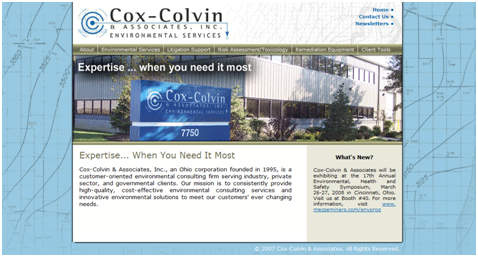Friday, January 21, 2011
EPA Considers Establishing an Enforceable MCL for Hexavalent Chromium
Since 2008, EPA has been re-evaluating its 20-year old drinking water standard for total chromium with respect to the carcinogenicity of orally ingested hexavalent chromium (chromium-6), the more toxic species of the metal. EPA is being pressured about the findings of a draft assessment of chromium-6 by both industry (claiming overestimate of risk) and environmental groups (claiming underestimate of risk). Whatever the outcome of the argument, EPA is likely to establish a chromium-6 MCL that is significantly lower than the current total chromium standard. This will have major implications for sites investigating, monitoring, or remediating media impacted by chromium-6, as well as for our nation's municipal drinking water supply systems. Click Here to read more.
Thursday, January 20, 2011
Ohio EPA Issues Latest Version of Draft 506 Rules (Multi-Program Groundwater Monitoring Rules)
Ohio EPA's first draft of the multi-program groundwater monitoring rules (OAC 3745-506), issued in 2006, was met with substantial comment from stakeholders and interested parties. On January 3, 2011, Ohio EPA issued their revised draft 506 Rules. Other draft rules issued recently by Ohio EPA appear to indicate that they intend to fast track implementation of the multi-program rules. Cox-Colvin is currently reviewing the draft language and will be providing periodic updates as we approach the April 1, 2011 comment deadline. Click Here to read more.
Changes in Asbestos Reporting Requirements
In the past, many asbestos assessments were reported in a highly casual way. Although they might have met the immediate needs of the property owner, the lack of documentation often made it difficult to interpret the results years later, and resulted in weak evidence when asbestos issues went to court. Consequently, effective January 1, 2011, as explained in a memo from the Ohio Department of Health on August 24, 2010, “Asbestos Hazard Evaluation Specialists shall collect all bulk samples for asbestos in accordance with the Asbestos Hazard Emergency Response Act (AHERA) 40 CFR Part 763.86 [O.A.C. 3701-34-06(C)(9)] and prepare a detailed AHERA type report for each site where bulk samples are collected [O.A.C. 3701-34-06(C)(10)].”
The AHERA rules were designed to protect public school students from asbestos, but increasingly are applied to other settings. Asbestos assessments in Ohio must now include the exact location where each bulk sample is collected, dates that samples are collected, and homogeneous areas where material is assumed to be asbestos-containing. The report must also describe the manner used to determine sampling locations, and must provide other documentation concerning the credentials of the asbestos inspector.
The AHERA rules were designed to protect public school students from asbestos, but increasingly are applied to other settings. Asbestos assessments in Ohio must now include the exact location where each bulk sample is collected, dates that samples are collected, and homogeneous areas where material is assumed to be asbestos-containing. The report must also describe the manner used to determine sampling locations, and must provide other documentation concerning the credentials of the asbestos inspector.
Monday, January 10, 2011
Cox-Colvin & Associates Staff to Speak at Ohio Brownfield Conference 2011
Cox-Colvin staff will be presenting three talks at the Ohio Brownfield Conference 2011, to be held at the Embassy Suites in Dublin, Ohio on January 19 - 20, 2011. Craig Cox, CP will be presenting two case studies of brownfields successfully completed by Cox-Colvin, entitled "Remediation of a Skeet Shooting Range" and "Successful Closure of a DNAPL site". In addition, Nick Petruzzi, PE will be presenting his expertise on "Green and Sustainable Remediation: Application, Uncertainties/Barriers and Future Direction". Cox-Colvin also will have an exhibit booth at the conference. Stop by and see us!
Labels:
brownfield,
Green and Sustainable Remediation,
GSR
Subscribe to:
Posts (Atom)




